A Guide to the Pelvic Floor for Men and Women
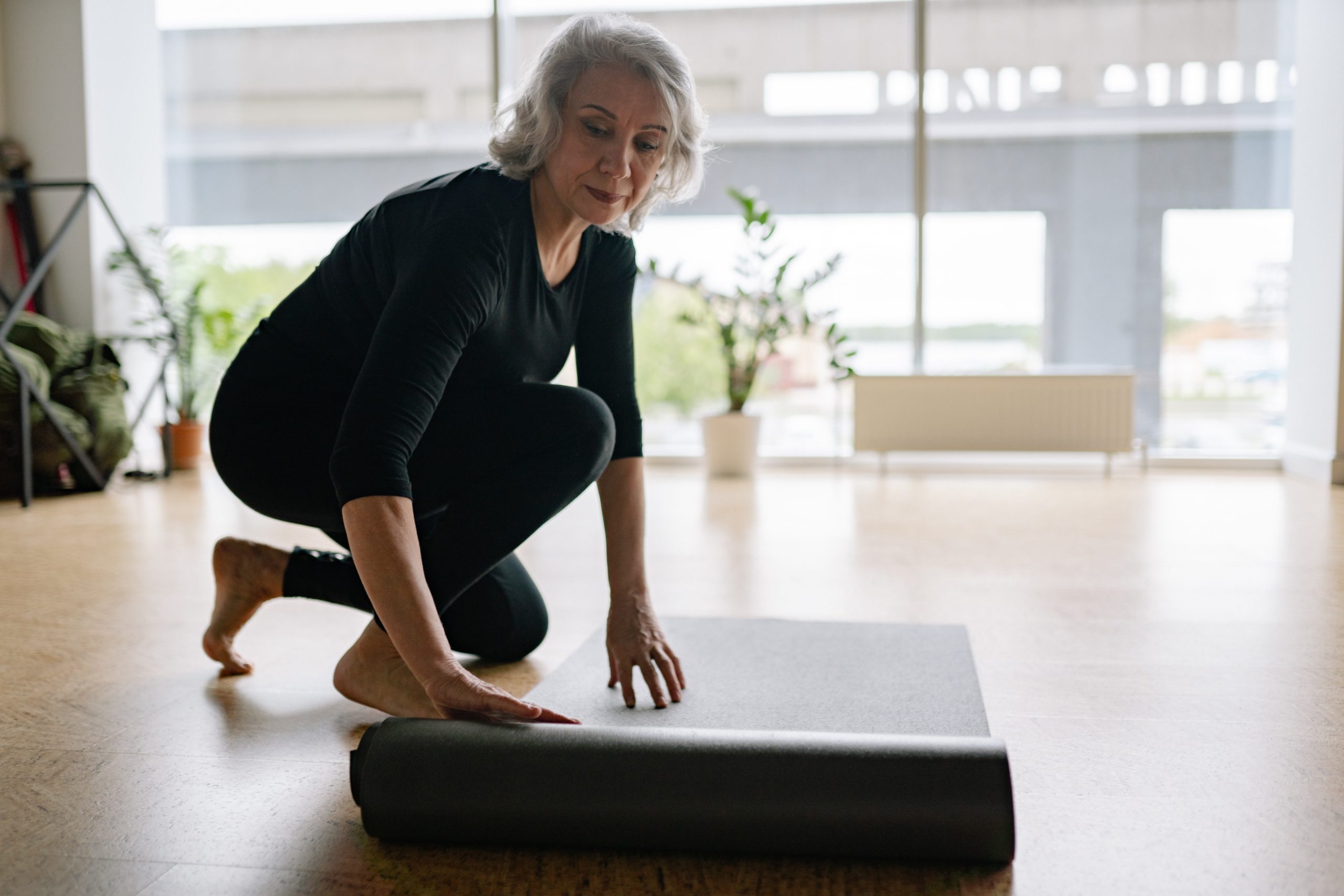
The pelvic floor is a group of muscles within the pelvis that stretch between the pubic bone at the front of the body to the tailbone at the back. These muscles support the pelvic organs including the bladder, rectum, as well as the uterus and vagina or the prostate. They also work with the abdominal and back muscles to support and stabilize the spine, help with urination and bowel movements and play an important role in healthy sexual function.
When the muscles of the pelvic floor weaken or become tight, you can experience a range of issues including urine and fecal incontinence as well as low back pain. In more severe cases, the pelvic organs can slip down or prolapse from their normal position causing pain and discomfort. Pelvic floor disorders are often associated with people who identify as women, but men can also experience symptoms.
While the risk of developing pelvic floor dysfunction does increase with age, pelvic floor issues are not considered a normal part of aging. Discussing these types of problems can be difficult and unfortunately awareness around the conditions, symptoms and treatments remains low. Read on for more about symptoms to watch out for, the causes of pelvic floor issues and strengthening exercises that may be helpful.
Symptoms of Pelvic Floor Disorders
Pelvic floor disorders occur when the muscles that support the pelvic organs become weak or damaged and cannot contract or relax as they should. Symptoms of a pelvic floor problem can include:
- Frequent urge to urinate or pain when urinating
- Pelvic pressure or heaviness
- Pain in the pelvis, genitals or rectum
- Leaking of urine or feces
- Constipation
- Lower back pain
- Painful or uncomfortable sexual intercourse
- Erectile dysfunction
Many of these symptoms can be caused by other conditions or illnesses so you should always be properly assessed by a health professional.
Causes of Pelvic Floor Issues
There are many factors that can affect your pelvic floor health including:
- Pregnancy and childbirth
- Hormonal changes during menopause
- Genetics
- Chronic cough (from smoking, asthma or allergies)
- Constipation
- Weight gain
- Repeated heavy lifting
- High-impact exercise
- Prolonged sitting
- Pelvic injury from a fall, surgery or trauma
- Neurological disorders like Parkinson’s Disease or Multiple Sclerosis
Treatment for Pelvic Floor Weakness or Disorders
If you are experiencing pelvic floor issues, particularly with a loss of bowel or bladder control, reach out to your doctor and a pelvic floor therapist. Your health professional may recommend lifestyle or diet changes, medications like laxatives or muscles relaxants. In some cases, a medical intervention may be recommended to address the problem.
For those experiencing mild symptoms, daily exercise can be a good way to strengthen these muscles and to keep your pelvic floor healthy. However, performing exercises that are not appropriate for your particular condition could make your symptoms worse. For example, different exercises will be recommended based on whether your pelvic floor muscles are tight or weak. It is always recommended to seek guidance from a doctor or pelvic floor therapist before beginning any pelvic exercise routine. It is important to remember that it may take a number of months to see improvements, especially if those muscles are weak.
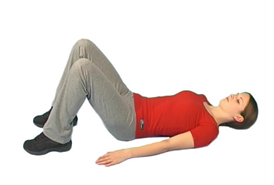
Demonstration of Kegel exercise position; Photo source: Physiotools
Kegel
Kegel exercises focus on both lifting and releasing the pelvic floor. It can be difficult to locate the muscles of the pelvic floor, so this is a great introductory exercise. Although many people associate Kegels with women’s heath, these exercises can also be very beneficial for men.
- Begin in a position that is comfortable and allows you to feel the exercise. This could be sitting, lying down on your back or your side, or even on all fours.
- Start with some slow breaths in and out, relaxing your body.
- Take a deep breath in. As you exhale, tighten your anus and vagina, lift them both inwards and upwards towards your navel, and squeeze as if you are stopping the flow of urine and holding back gas all at the same time. Try to avoid clenching your buttocks or thigh muscles.
- Hold for 3 seconds.
- With your next inhale, release your pelvic floor back to a resting position, making sure that you have a distinct feeling of letting go.
- Repeat 2-3 times and repeat 3 times a day. Ensure that you are using good technique.
- As you get accustomed to the exercise, you can gradually increase this to 8-12 repetitions, up to 10 second hold and rest for 6-10 seconds between repetitions. This can be repeated 2-3 times/day on most days.
Once you’re more comfortable, you can do Kegels anywhere and in any position. Try to also contract these muscles every time you sneeze, cough or lift something heavy. Do not stop your urine midstream to engage and strengthen these muscles. This can cause incomplete emptying of the bladder, increasing your risk of urinary tract infections or other urinary disorders.
Kegels aren’t the only way to strengthen the pelvic floor. Exercises that focus on the hips, buttocks and abdominals are also helpful because they provide stability by strengthening the surrounding muscles. A physiotherapist can show you many more options, but these exercises may be a good starting point. All of these exercises should be done on a soft surface like a yoga mat or on your bed if getting down on the ground is not possible.
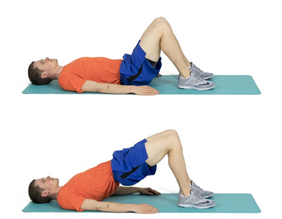
Demonstration of Bridge exercise position; Photo source: Physiotools
Bridge
This exercise combines a bridge with Kegel exercises to strengthen the buttocks (or glutes), lower back, abdominals and pelvic floor.
- Lie on your back, knees bent and hip distance apart, feet firmly on the floor and hands by your side with palms facing down.
- Take a deep breath in. As you exhale, squeeze your glutes and contract your pelvic floor like in a Kegel, lifting your hips up off the ground. Hold for 5 seconds.
- Inhale and slowly lower your bottom back to the ground, releasing your pelvic floor muscles.
- Repeat 5 times.
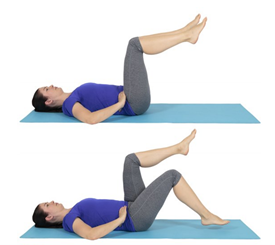
Demonstration of Toe Tap exercise; Photo source: Physiotools
Toe Tap
This exercise works to strengthen the muscles of the core and pelvic floor.
- Lay on your back and lift your legs up to table top, knees bent, shins parallel with the ground and arms straight at your side. Pull your belly button in towards your spine to flatten the arch in your back.
- Keeping your spine stable, inhale to lower your right toes to the floor.
- Exhale, engage the pelvic floor and belly then lift your right leg back up to the starting position.
- Repeat toe tap with the left leg, alternating for 3-5 reps on each side. You can gradually increase the number of repetitions as you become stronger.
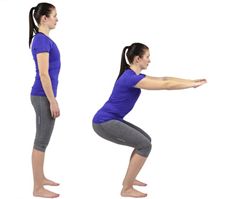
Demonstration of Squat exercise; Photo source: Physiotools
Squat
This exercise strengthens the hips, glutes, legs, core and pelvic floor. Hold onto a counter in your home for additional support.
- Stand tall with feet hip-width apart.
- Inhale and bend at the knees lowering your bottom towards the floor as if you are going to sit down on a stool. Do not let you knees go past your toes as you lower down. You can do this while holding onto the counter or without the support of your hands.
- Exhale and engage your pelvic floor and buttocks as you rise to a standing position, bringing your hands back to your side or keeping them on the edge of the counter.
- Repeat 5-10 times.
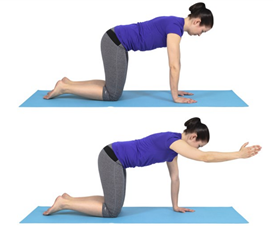
Demonstration of Bird Dog exercise; Photo source: Physiotools
Bird Dog
This exercise strengthens the abdominals, back, glutes and hips to provide more stability for the pelvic floor.
- Start on all fours. Position your shoulders over your wrists, your hips over your knees and make sure that your back is flat. Look down and slightly ahead of you on the floor to keep your neck long.
- Without raising your head, engage your core and pelvic floor. Extend your right arm in front of you. If you are looking for more of a challenge, also lift your left leg straight up behind you.
- Hold for a few seconds then slowly bring your arm and leg (optional) back down.
- Repeat the exercise 5 times on one side, then repeat on the other.
- If you experience any difficulties or discomfort during these exercises, stop immediately and speak to your doctor or physiotherapist.
Reviewed By: Audrey Letouze, PT
If you enjoyed this article, you may also like to read:
